Homemade Pesto
A vibrant pesto recipe taught to me by my friend Francesca's mother who came to visit from Genoa, Italy. This is how to make pesto like an Italian grandmother. Made with hand-chopped basil, garlic, Parmesan, olive oil and pine nuts. The real deal.

If you've ever tasted pesto in Italy you know that the pesto here in the United States just isn't the same. I received a lesson in how to make pesto from a real Italian grandmother last week and now I understand the difference and what makes this pesto recipe so special.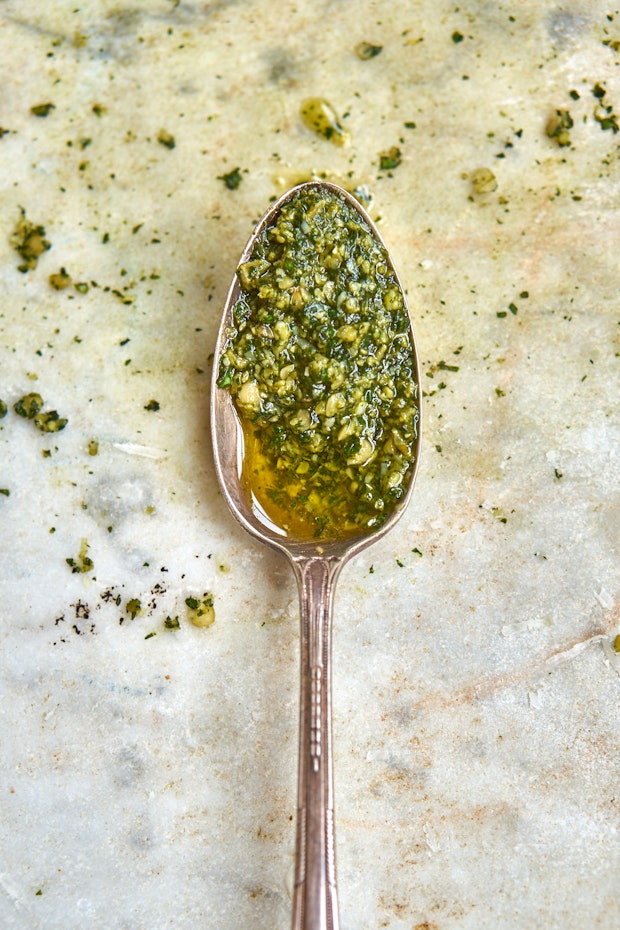
A Special Pesto
My friend Francesca makes the trip from her small town near the pesto-epicenter of Genoa, Italy to San Francisco once or twice a year - this time (lucky for us) she brought her mom and two-year old son Mattia. Her mom makes a beautiful pesto (and perfectly light, potato gnocchi to go along with it) and offered to show me and my friend Jen how it is done. I have to say, it was a complete game-changer. If you love pesto, you really have to try this. Her technique results in an incredibly special version.
Pesto Technique
Most of the pesto you encounter here in the U.S. is different for a few reasons. First off, most of what you see is made by machine, usually a food processor or hand blender. The cook will pulse into a paste. This holds true even if it is homemade. Don't get me wrong, it usually tastes good, but because the ingredients aren't hand chopped you end up with a texture that is more like like a moist, uniform paste with little to no definition between ingredients. You also might see pesto made with a mortar and pestle. This pesto is something different.
During my lesson I quickly began to realize chopping all the ingredients by hand is key because this prevents the ingredients from becoming a completely homogenized emulsion or paste. When you dress a pasta with a pesto that has been hand chopped the minuscule flecks of basil will separate from the olive oil, pine nuts, and Parmesan cheese in places. You get definition between ingredients, and bright flavors pop in a way they don't when they've been blended into one.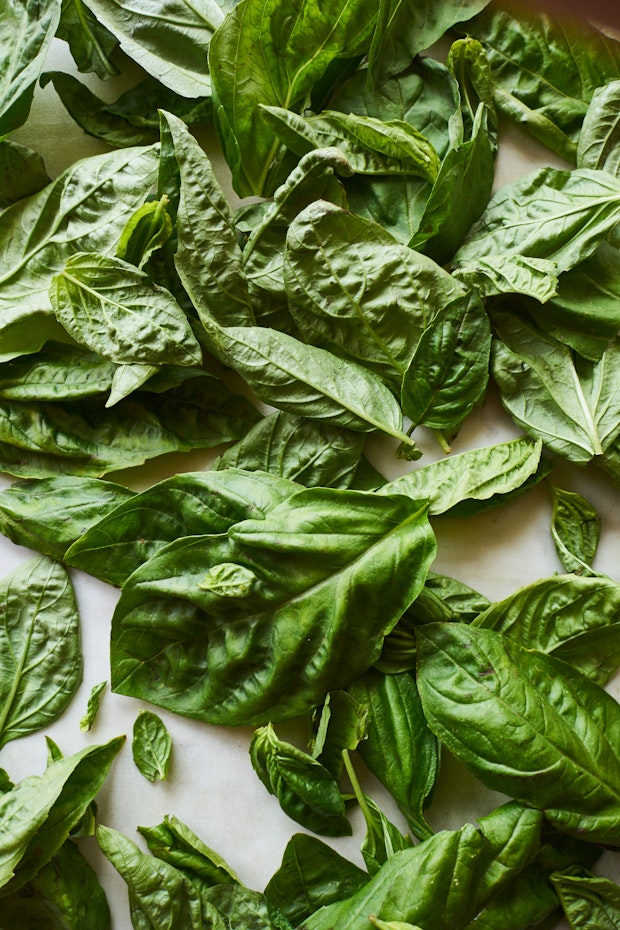
Video: How to Make Pesto
Choosing The Best Basil for Making Pesto
Genovese pesto is famous in part because it is often made with young, small fresh basil leaves. For us non-Italians it is easy to find Genovese basil in stores and at farmer's markets, particularly in the summer. That said, chances are it wasn't picked young. I wouldn't worry about it too much, simply by hand chopping all your ingredients, you will see a major shift in personality of your pesto.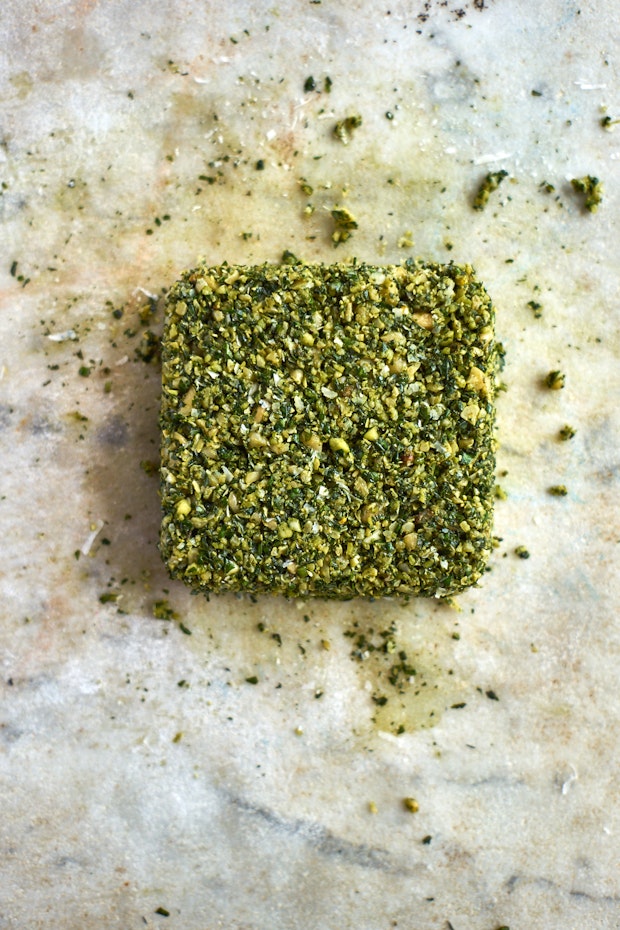
Chop by Hand or Blender?
Per the above, this pesto celebrates hand-chopping. Correspondingly, if you're serious about making good pesto using the hand-chop technique you'll need a sharp (preferably large, single blade) mezzaluna, or a good knife. The sharpness of your blade absolutely matters because you don't want to bruise or tear your basil. Whatever you use to chop, make sure it has a sharp blade or the basil will turn dark. Chopping the ingredients will take twenty minutes or so. Once you chop your ingredients, you'll form them into a cake, pictured above. You add olive oil to this cake, and it's magic.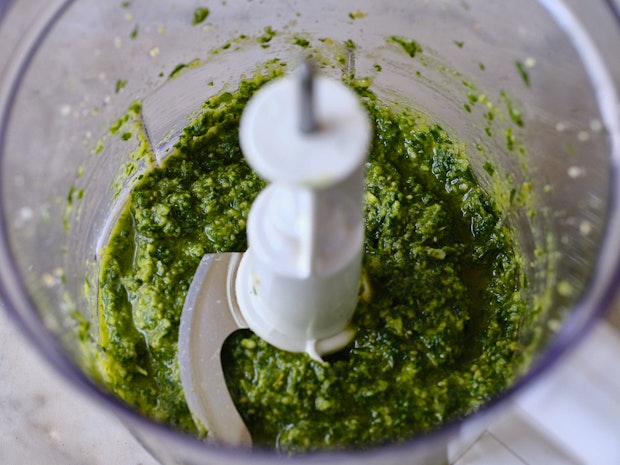
How to Make Pesto with a Blender or Food Processor
We don't always have time to hand chop, I get it! If you want to make pesto using a blender or food processor here's how. Pulse the garlic and pine nuts into a chunky paste. Use the quantities in the recipe below. Add the basil and pulse into a bright green paste. Pulse in the olive oil, adding more if you want a thinner texture. Stir in the grated cheese by hand and season with a bit of salt if needed. Some days, are going to be blender pesto days!
How to Store Basil
There are a number of great ways to keep basil fresh until you’re ready to use it. If you think you’ll use it within a day or two, keep the basil in a jar of water on your countertop. The way you’d keep a bouquet of flowers. If you think it will be a few days beyond that, treat the basil like you would salad greens. Give the basil a gentle wash, then wrap the leaves in a clean kitchen towel or paper towels, place this in a baggie, and refrigerate until ready to use.
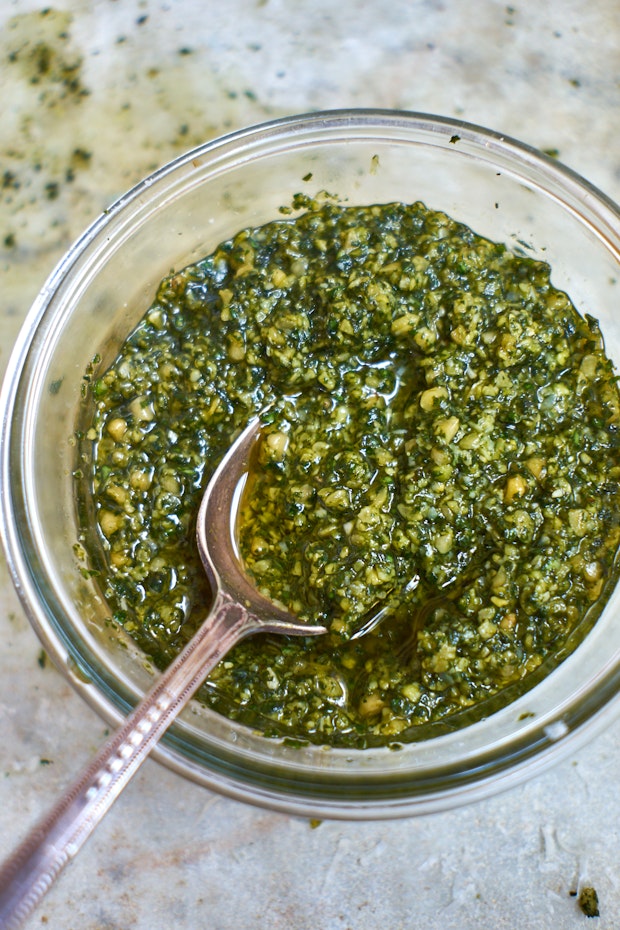
Favorite Ways to Use Pesto
What do you eat pesto with? There are so many great ways to use pesto - some traditional, many not. I love a thick slather as the base sauce on a good pizza (this page actually has an extended list of pizza topping ideas). Or, on a tart before adding other toppings. If you have a slab of sourdough coming off the grill, a bit of pesto, some seasonal roasted veggies, and a dusting of cheese makes an easy meal. And because it lends a bolt of flavor, I love to whisk a dollop into scrambled eggs, or an omelette, mashed potatoes, or on baked potatoes.
How to Store Pesto
Generally speaking, store any pesto you might use in the next day or two, refrigerated, under a thin film of olive oil. You can also freeze it in snack-sized baggies. Thaw and toss with whatever gnocchi, ravioli, or other favorite pasta you like - and a good splash of pasta water!
- How Do I Keep Pesto from Turning Brown? There are a couple ways to keep your pesto bright green. Browning comes from oxidizing. One way to prevent this is to limit exposure to air. Because of this, I like to keep pesto in my narrowest jar with a thin layer of olive oil on top so that no pesto is exposed to air. The other option is to blanch your basil leaves briefly, and proceed with your pesto-making from there. I almost always opt for option one.
- Can Pesto Be Frozen? Yes! You can absolutely freeze pesto. Any pesto you won’t use within a couple days, transfer to freezer baggies. Freeze flat, and break off chunks of pesto to use whenever you need it. When you need larger quantities defrost the entire bag either in the refrigerator or on your countertop.
Pesto Variations
Don't limit yourself to basil pesto. You can absolutely experiment with a blend of other herbs as well. You can add anything from parsley to marjoram (a favorite!), mint to fresh oregano to your basil base. Or leave the basil out entirely! I like to add citrus zest on occasion, or switch up the type of nuts I use - toasted almonds and walnuts are favorites.
Let me know if you try this and what you think!
More Pasta Recipes
- Homemade Pasta
- Pappardelle
- Cavatelli
- Pici
- Beet Fettuccine
- Mushroom Lasagna
- Pasta with Crushed Creamy Walnut Sauce
- Stuffed Shells
- Last Minute Red Lasagna
- more pasta recipes
Favorite Pasta Sauces
Other Favorite Italian Recipes
Homemade Pesto
One key to perfect pesto is chopping all the ingredients by hand, preferably with a sharp mezzaluna or knife. This pesto will keep a bit in the refrigerator, but it really hits its peak when served soon after it is made. The technique here is: chop a bit, add some ingredients, chop some more. I think part of the reason she does it this way, instead of chopping everything all at once, is because some things get chopped into oblivion. Other ingredients, not as much. It encourages a spectrum of cut sizes throughout the pesto contributing to the overall texture. All told, the chopping took me a leisurely twenty to thirty minutes, I wasn't in any particular rush. You'll also notice this recipe doesn't have any added salt (just the saltiness from the cheese), make sure your pasta water is well salted if you are going to use this pesto on pasta. If you skip it the overall flavor profile will fall flat. Also, be sure to adjust for seasoning before serving. With food this simple, you need to get the seasoning right. Trust your tastebuds.
- 1 large bunch of basil, leaves only, washed and dried
- 3 medium cloves of garlic
- one small handful of raw pine nuts
- roughly 3/4 cup Parmesan, loosely packed and freshly grated
- A few tablespoons of extra-virgin olive oil
-
Start chopping the garlic along with about 1/3 of the basil leaves. Once this is loosely chopped add more basil, chop some more, add the rest of the basil, chop some more. I scrape and chop, gather and chop. At this point the basil and garlic should be a very fine mince. Add about half the pine nuts, chop. Add the rest of the pine nuts, chop. Add half of the Parmesan, chop. Add the rest of the Parmesan, and chop. In the end you want a chop so fine that you can press all the ingredients into a basil "cake" - see the photo up above. Transfer the pesto "cake" to a small bowl (not much bigger than the cake).
-
Cover the pesto "cake" with a bit of olive oil. It doesn't take much, just a few tablespoons. At this point, you can set the pesto aside, or place it in the refrigerator until you are ready to use it. Just before serving, give the pesto a quick stir to incorporate some of the oil into the basil. Francesca's mom occasionally thins the pesto with a splash of pasta water for more coverage, but for our gnocchi this wasn't necessary.


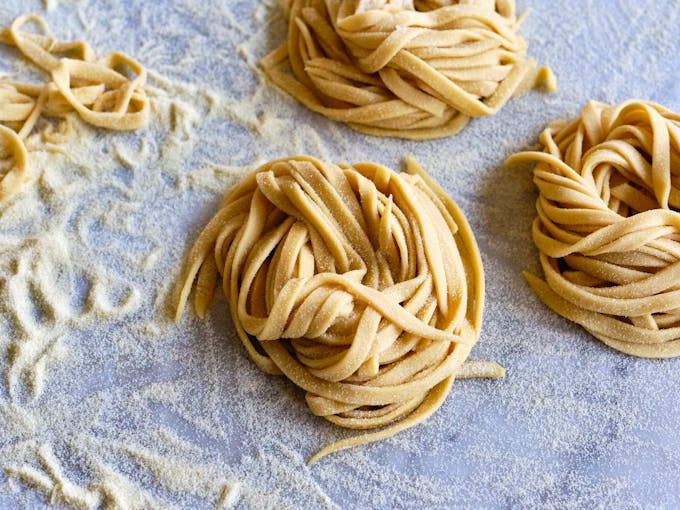
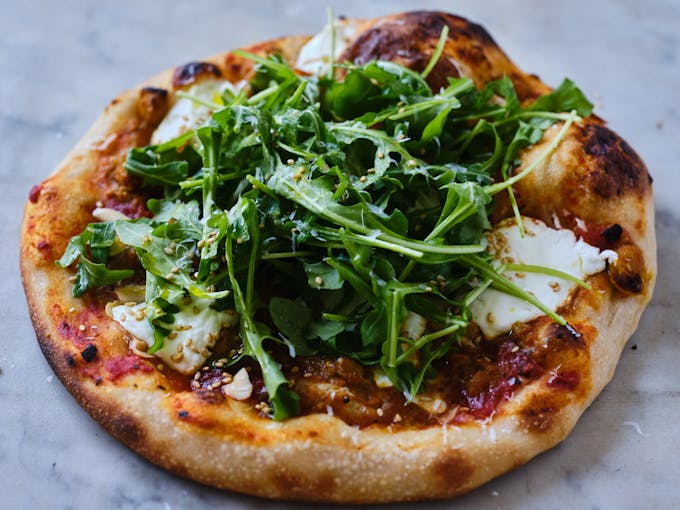

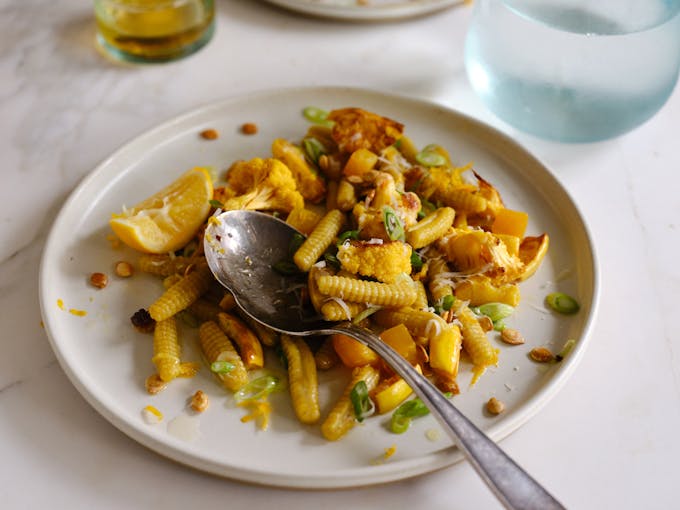
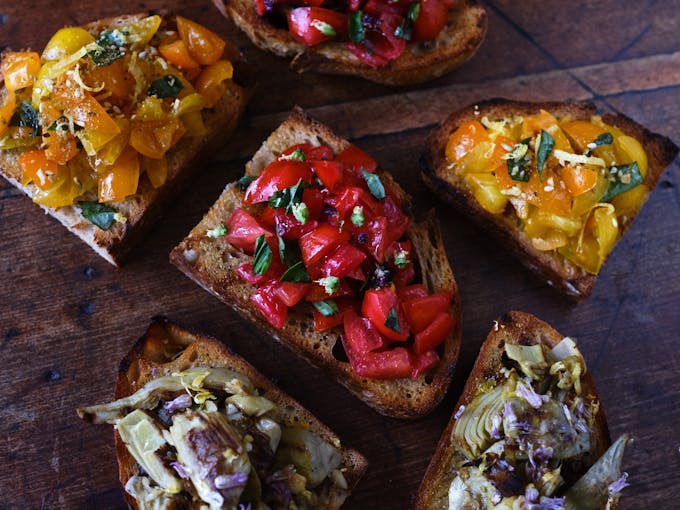

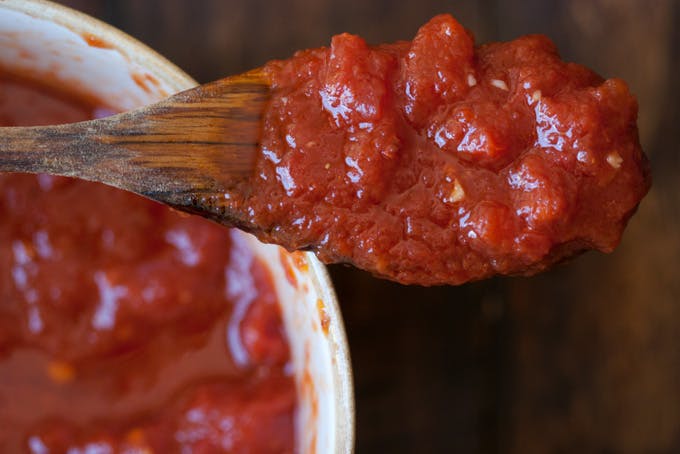
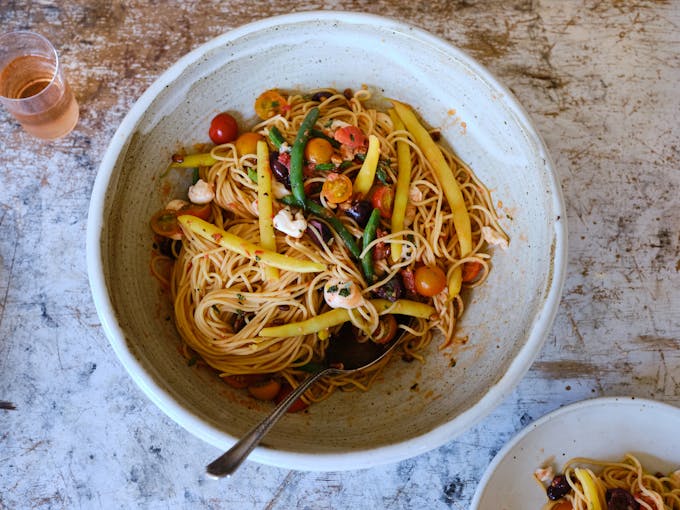
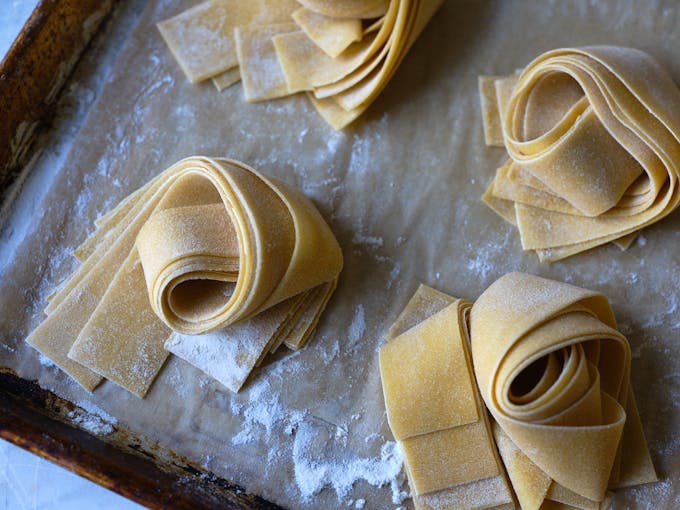
Post Your Comment
Comments
My “brother” is a pesto fanatic and has had it all over the US from coast to coast. I made this for him and he said it is hands down the best pesto he’s ever had. I bought a messaluna just to make this for him. It’s the only pesto he will eat now. He took some to work and one of his coworkers said his Italian friend made it. I’m half Korean and he thought it was hilarious.
This is the best.
Thanks for the lovely recipe. I have made it twice in the last month. This time I toasted the pine nuts and just wondering if it is a preference to not toast them in your recipe. Or if there is a specific reason. We will eat it tonight so I won’t know until then my preference.
Hi Jill! You should absolutely do it whichever way you prefer. I was taught using raw, and tend to prefer that flavor profile with the fresh basil. But it’s hard to go wrong either way – it’s fresh pesto.
I made your pesto recipe ….followed each step
I only had pecans so that what I used
I hope I never have to make pesto in a machine again
I have a cleaver that I’ve been using for years and it came in most handy for chopping this recipe
So happy I came across this recipe
Gramma caught my eye
They do know best
Happy chopping
Lynda
Thanks Lynda – so glad you liked it!
An interesting, different, certainly brave approach, but having tried it, the garlic made it taste more like salsa verde than pesto. It also emulsifies better if made the authentic way in a pestle and mortar, which I prefer with a mix of Pecorino Romano and Parmiggiano Regiano to add depth of flavour, to just plain garlic.
Can you please post a picture of the pesto with it on the pasta, mine wouldn’t smooth out for some reason. Taste is great but I think I did something wrong because it was chunks even when I added pasta water. I’ve never made this before and I’m sure I didn’t do something wrong …lol
Hi Christine – here’s a page where you can see the pesto tossed with the gnocchi.
Absolutely the BEST pesto. Yes, takes some chopping effort but the result is more than worth it! I shared your recipe it with my cousin who’s grandson adores it. I decimated my six basil plants to make some pesto pasta for a BBQ with friends last weekend, got rave reviews. Thank you! (and the basil will grow back)
So happy to hear it Cathy!
Making pesto this way is a total game changer for me. I used to always make it in the food processor and by chance I was staying in an RV and found your recipe using just a knife. Wow – what a huge difference in flavor and mouthfeel. I am never going back to using the food processor!
Hi Olivia – fantastic! So happy you liked it!
How to store basil: Basil will last almost indefinitely in water on the counter. I have tested this all summer. Some of it will even root. Washing it and putting in paper towels will only last a few days. Treat the basil like you would in the garden and cut back those flowers.
Yup. This is the stuff you pull out to impress the guests.
I always chopped the basil so to limit the need for the food processor, thus reducing potential bitterness. But the process featured here is so intuitive that my feeble mind never quite got wrapped around what should have been obvious.
I took a chance and tripled the recipe. I have that wonderful garden blessing of having too much basil to consume between my husband and I. So, I freeze a good bit of pesto in ice trays so we can enjoy it year around.
Pine Nuts are my personal favorite for pesto, but one time, I used raw, shelled pistachios. Using pistachios in pesto is an excellent Plan B IMO.
Thanks for this. I consider myself a somewhat advanced home cook, but I love to learn new techniques…..This pesto is just fantastic.
Thanks Carol – so happy you gave it a try!
This looks fabulous! Could you be more precise about how much basil? “One large bunch” is not useful for those of us who grow our own. And the commentator who recommended “40 leaves” is also not useful because leaves can vary wildly in size. For example, my usual go-to recipe specifies 2 cups of “solidly packed” basil leaves for enough sauce to coat 1 lb of pasta. That recipe is Julia della Croce’s Pesto alla Genovese, mortar and pestle method, in her _Pasta Classsica: The Art of Italian Pasta Cooking_ (Chronicle Books, 1987). Thank you!
Hi Heidi –
I can’t thank you enough for this recipe. I nursed a beautiful pot of basil from seed. I had to pick it this week because it was getting to big. Once in the kitchen, expecting to whip up some pesto in 10 minutes, I found that my food processor was broken. I frantically turned to the internet to see how pesto was made prior to modern convenience. I was so grateful to find your recipe! I have never tasted such delicious pesto, even at the best restaurants! I’m going to definitely visit your other recipes and can’t wait to get started! Thank you again!!!
So happy it saved the day Jane!
Thanks! Boiling gnocchi now, I hope it turns out!
Dear Heidi –
Especially This recipe and your gnocchi recipe absolutely rock – but they all inspire me- thank you!
My question is about Organic Extra Virgin Olive Oil. There is so much controversy about EVOO and which certifying agency is real or not, etc…
I don’t feel educated/in the field enough to know what is good value and healthy and what isn’t, when it comes to EVOO.
Can you please recommend an Organic EVOO brand or two that is pure, and perhaps the healthiest for the money?
Unfortunately I can’t spend 25-30$ for 350-500ml.
Are there good brands that are more affordable in your opinion? Or am I stuck at that price point if I want unadulterated EVOO?…
You know, I think if you sold key ingredients you believe in, there’s business to be had.
Thanks so much
Hi Johanna! Thank you! Have a look at the Bariani family extra-virgin olive oils. You can buy a 1000ml for $23. I used to buy direct from them at the San Francisco Farmers’ Market. https://www.barianioliveoil.com/product/extra-virgin-olive-oil
Excellent recipe, made it a few times… I suggest toasting the pine nuts first
I just make this recipe using my bolo. Very sharp. I will never use a processor never again. Damn. It turns out to be a perfect pesto.
im italian, and since i was a little kid i would spend hours alone in my living room just making pesto with a mortar and pestle as it is originally done- i took a fieldtrip when i was very small to genova and they taught me to make it. this recipe is super traditional yet something we can all do a lot more easily than using the mortar each time! thank you xxx
I just made this pesto using my Cutco Santuko knife. I followed this recipe and another blogger who credited her recipe back here.
Mmmmmm…I will NEVER use a machine to make pesto again! This is so bright, bursting with bold flavors, and beautiful!! Easy to do- not at all intimidating.
Thank you!!!
So happy you liked it Karen!
Just made the pesto. There is A LOT. Can I freeze it? How?
You can!
Thank you for this recipe! It sounds very delicious but I have a question. What can I use to replace Parmesan?
Hi Joshua – there are some suggestions in the comments. You could use an alternative cheese, go the nutritional yeast route. You want something a little creamy, salty.
Traditional pesto in Genoa is made with a mortar and pestle. The word “pesto” in Italian derives from the verb “pester” which means roughly “to stamp/tread/smash”. Many years ago when I lived in Italy I also learned how to make pesto, with a great-grandmother Genovese, using a “mezzaluna” which she considered “more modern”!
I’ve been making my pesto this way since you originally posted this. I’m lucky in that fresh basil is almost always in the garden or in the house and this method works and tastes great! Now when I have it the other way (blended smooth), it’s like there’s something missing. Thanks for enlightening me!
Hi Heidi, I love your recipes, photos and stories. Great recipe; thanks!
Hello from Argentina!! I am the granddaughter of a wonderful couple of Italians born in Genova (Giovani Battista and Terzilla Olivieri). For me, pesto is a childhood flavour. Wonderful taste, great texture. Just one thing, from my early memories of sunday mornigs, when home made pasta was a must: I understand from your recipe that you chop with a blade; I saw my grandparents use a wooden mortar and pestle. Also, to prevent oxidation of basil (turning black), you can cover the pesto with olive oil, to prevent oxigen from reaching the ingredients.
Thanks!!!
I found your site through Design*Sponge and have to say I love your site. I bookmarked you and plan on returning later to read your archives!
Thanks for the tip, it’s fabulous! I have always loved Italian food.
Terrific! There’s nothing like a good, fresh pesto. You can also experiment with other ingredients: replace the basil with a couple of roasted red peppers to get a roasted red pepper pesto. You will need a blender in this case, and some seasoning, but it makes an unbelievable pesto, which can also be used as a dip for fresh vegetables.
Bon appetito!
ubercool!!! I’ll try this tonight! (I do cultivate my own basil 🙂 )
Hi,
I live in Liguria (near Cinque Terre) and I can say that in nearly every household in Liguria pesto is made, nowdays with an electric blender and it tastes very good. I guess what really makes a difference is the basil (young leaves as you said), especially if grown in the area of Genova Pra (for the composition of soil), but also the quality of parmesan (or pecorino) cheese and the pinenuts used. Handchopped? Pesto is traditionally made with mortar and pestle, but I guess every ligurian has few tricks up his or her sleeves to make pesto as wonderful as only it can be. Your version looks pretty inviting and authentic, though : )
Yes, this is completely true…I was so dissappointed with pesto’s across the board (grocery stores, specialty, gourmet) that I also started chopping/mixing all my ingredients (when making pesto) by hand or by mortar and pestle. It makes such a difference for folding/tossing with pasta’s but also for light pizza’s (made without marinara). Luckily for me my local grocery store has started carrying basil micro-greens…the classic Genovese flavor is even more intense at the seedling stage. Or instead of the balsamic/extra virgin olive oil on top of the fresh mozzarella, tomato salads (I like a little thin sliced red onion rings too) top it with this pesto instead!
The pesto sounds fabulous.
I just picked up your cookbook at Books Inc in Palo Alto (the Stanford Mall store). I can’t wait to try it out!
I’ve done quite a bit of ‘apprenticing’ in friends’ mothers’ kitchens all over Italy and have found that most of them either use the mortar and pestle or the food processor. By hand cutting, I fear you wouldn’t release the flavor in the basil that a more ‘violent’ technique serves to enhance. Might the salt help keep the leaves from darkening? Anyway– for the person with pinoli (pine nut) allergy issues, try a search for Sicilian pesto and try that out! Nice.
tlc p.s. also, try the Saveur magazine archive for another good pesto recipe
i learned pesto making using a mortar and pestle; but, a food processor is much easier. i never heard of making it with a knive. that sound like a lot of work. what i do is i grind the ingredients separately to control the texture. first i do the cheese. then i chop the nuts. i do coarse chopped load of basil. and another load of finely chopped basil with the garlic. i mix them together in a bowl and adjust the olive oil and seasoning. note: i place oil and salt with the basil to assist in the chopping. i freeze these for uptill two months in small containers topped up with oil.
To Jamie S:
The best way to store pesto is to pack it in a jar and flatten the surface making sure there are no air bubbles. Then just cover the top with a thin layer of olive oil.
This will keep for a week in the fridge.
One more tip.
Try to use mediterranean pinenuts. They’re completely different from the asian ones. The flavour is so much more complex. I also find that using a pestel and mortar makes a fantastic pesto. Just add the pinenuts more at the end so they don’t disapear completely.
I grew up without a food processor or blender and so made pesto as kid by chopping the basil with a knife. We’d stop by a farm stand on the way home and buy enormous bundles of basil and a few tomatoes. Then we’d go home and make pesto to put on some pasta and a plate of tomatoes with fresh mozzarella, strips of more basil and a slosh of olive oil. I think I had a good childhood. More recently, I’ve purchased a blender and make pesto mechanically. Perhaps I’ll get a good mortar and pestle in the next few months. I like pesto as made by chopping as well as by food processor. They’re different but both good.
Great article! Now I know what to do with the basil plant on the window sill!
Great (and useful) post! One question I have is about storing pesto. Do you leave it in a bowl with plastic wrap? A jar? Sometimes it goes from bright green to brown (eww). What about lemon juice like gaucamole? I guess that ruins the flavor? Thanks!
Any excuse to buy a mezzaluna, I always say . . .
This technique is a lot like making pico de gallo salsa where you chop each ingredient and slowly add them and keep chopping. The flavor and more importantly the texture are so much better than if it got pulsed in a Cuisinart.
You can substitute nuts like pecans or almonds, they must be toasted, it wil taste different but good. You can substitute cilantro for basil as well – great on burritos!
No way! Stick to the real ingredients folks 😉
Sorry for the delay in responding (this week has been unusually busy!) – regardless, it looks like you all came up with plenty of great suggestions on your own. I love reading them.
Robin, I’m not exactly sure what the inspiration was behind the naming of Mattia, but HC’s insight is interesting. I will ask her, I suspect there is a story there, but it might be a personal one.
As far as the chop vs. smash debate goes: I’ve done pesto with the mortar and pestle before as well (also wonderful), but really love everything about this particular method and the flavor and texture it yields…
i would venture to say that the difference between home-grown and store-bought basil is more telling than technical differences in how you process it into pesto sauce. herbs are so easy to grow, and the quality difference is just too great to even remember it properly when you have accustomed yourself to grocery store substitutes.
Heidi, as always another fabulous entry. I can’t wait for you to share the potato gnocchi recipe. I am a sucker for gnocchi; I see it on a menu I order it!
Heidi, I knew that you should chop by hand for better results, but I never heard that you should chop, add, chop, add and so on… I will definitly try this next time I make pesto! Thanks for all those details!
Ps: The more I hear about your book, the more I itch to order it. Lucky amazon ‘s here!
@Heidi and especially @Fabien – a VERY IMPORTANT POINT from my Italian wife: Genovese basil (Ocimum Basilicum ‘Genovese’ I believe, aka ‘Lemon Basil’), like the basil grown throughout Provence, just down the coast in France, does *not* have very large leaves! The fully mature leaves are small and flat compared to the curled variety commonly found in the US and elsewhere. They are also a lighter shade of green and have a delicate flavor all their own. There are 150 types of basil (!) growing around the world (try making pesto with Thai basil for a wild variation), but for the true Genovese experience, making your pesto with this variety will take it to the next level.
I’ve also heard that pumpkin seeds can be substituted for pine nuts, but I haven’t tried this yet myself. I have successfully used pumpkin seeds in place of almonds in a red mole sauce. (My fiancée is allergic to tree nuts, peanuts, some forms of soy, and, sadly, mushrooms.)
My suggestion would be to substitute the pine nuts for pistachios. You’ll be surprised how much you won’t miss the pine nuts. Of course, taste is a personal thing, but at least give it a try.
Ms. Swanson,
I’ve used sharp kitchen scissors to good effect on herbs to avoid the darkening / brusing. If one is lacking a mezzaluna or half-moon pizza cutter, they might serve as well.
Just a thought…
-Jonathan
I’ve always toasted the pine nuts before chopping, to bring out more flavor. Is that not the case here?
Oh my! I just “food processed” my way to sun dried tomato pesto last night. When I told my mom about your post, her reply (since 1/2 my family is from Genoa) was – “Yes, how else should it be made?” Thanks mom….Missed that in my home-culinary lessons…ha! ha! ha! Thanks for this. I can’t wait to try it.
I’m pretty attached to my (American I guess!) pesto recipe but some time will have to try this traditional way, I do love pesto!
Thanks for that. In Katrineholm, Sweden we have pretty good pesto.
My husband bought your beautiful cookbook for me at Prairie Lights Bookstore, Iowa City, IA.
I love it. Thanks for writing/photographing it.
In Frankfurt we have a herb based sauce called „Grie Soß” (green sauce) which is very different to pesto, but its secret is the same: chopping it instead of blending because otherwise the sauce turns bitter and the very different tastes of the (seven) herbs mix too much.
Although I have always made pesto in the mortar I’ll try this, hoping for a more rough but singular taste of every ingredient. And to add one ingredient after the other just makes it easier to chop, I suppose. Thank you very much. (But: I wouldn’t wash the basil. And I’d add some salt and more oil, if you want the pesto last. Sorry for Denglish)
This recipe sounds fantastic, and being Italian, myself, I can tell it is made the old-fashioned way.
I can’t wait to try making pesto this way. It doesn’t sound overly difficult, and I can tell from the recipe that my dear Italian grandmother, would have used a recipe like this, in her life time.
Thank you.
Guilty as charged — I rely on my Cuisinart to make pesto, but after this post I will reconsider next time. Last year I did grow my own basil in window boxes off my railing, and while they did have a superior flavor to the bland store-bought creatures, they still didn’t compare to basil in Italy proper. I don’t know if it’s the soil, the sun, the water, or just being in Italy that makes the difference.
I love, though, that in Italy you buy basil as a living plant in the produce section. The flavor begins draining from the leaves the second the plant is cut. I wish we had that in our grocery stores.
Beautiful! Yum!
Heidi,
Regarding your plans to make a variation on the lasagne with pesto, my father-in-law (who lives near Florence) makes my favorite dish in the world which is simply alternating layers of bechamel sauce and pesto with lasagne. Put a generous dusting of parmesan/romano on each layer. Make sure you use a lot of the bechamel as it can turn out dry if you don’t.
When I was in Genova, as the commenter Andrea said, the pasta al pesto was prepared with boiled potatoes, which added an interesting texture and buttery flavor to the mix.
Just to be more precise “1 large bunch of basil” means at least 40 leaves… and consider that the original basil from Genova has large leaves… :))
This said, your recipe is very good and tasty 🙂
Wow, imagine such a little thing like hand chopping instead of machine chopping! I can see the difference and can’t wait to give it a try. I’ve lovely pots of basil plants growing on the patio!
Thanks for these ideas Heidi. I’ve been making a lot of asian pesto recently (with coriander and cashew nuts instead) and the texture was a bit smoother than I wanted it so I’ll definitely try this way out next time (I’ve got one of those mezzaluna gathering dust in the cupboard too!)
Great post and very insightful. I’m going to try your technique, I like the idea of seeing beautiful specs of basil on my pasta.
I like to substitute walnuts sometimes… and sometimes, I like to add finely diced sun-dried tomato slices. YUM. Thanks for the new technique.
Oh I’m thrilled you posted this! I have an excellent recipe for a pomodoro sauce with basil pesto, but all the sauces I found at the grocers looked so pastey and not-so fresh. I can’t wait to try it!
Thanks for sharing! I’ve never made pesto (I buy it from the supermarket) – but after reading this, I’m definitely going to give it a try.
It would be really great to fly to Italy as suggested in a previous comment. For now, I’m going to dream pesto dreams and make plans to grow basil this summer. The recipe here looks divine. I absolutely can’t wait for the gnocchi; my husband and I gave up making it after several disasters, but we’ve been thinking of revisiting it. Thanks for the pesto recipe.
Thanks for sharing this recipe. I look forward to trying it!
Heidi – I’m curious . . . what is the origin of “Mattia”? Our son is Matteo. I had never heard the previous version. Thanks for a continually inspirational blog!
Dear Heidi, Thank you for sharing this recipe. The input that one should chop and mix alternately seems invaluable. The pics are inviting – as always. I really like your title – how to Make Pesto like an Italian Grandmother – cant say it any better. Will try this for sure.
May I contribute to the definition of a “perfect pesto”? To release the higher possible quantity of the essential oils contained within the basil leaves, pesto should be made with mortar and pestle (pesto comes from “pestare” which is the word definig the action). Using the mezzaluna or any sharp implement will lessen the taste. The cheese should be a 50/50 blend of (real) parmigiano and (real) pecorino (romano or from Sardinia). The olive oil should be “extra virgin” (expression which only makes sense when talking of olive oil…).
Once ready the pesto can be used to season several types of pasta and even to correct a minestrone.
However the “pasta al pesto” typically served in Ligurian homes uses “TROFIE” (a sort of hand made, short type of pasta) boiled together with potatoes and string beans.
In my opinion it is possible to prepare excellent pasta dishes using all above suggestions, however to get the real thing I am afraid people should fly there.
Ciao!
Some things are just worth the time and effort. It is time to put my basil plants in the ground so that I too can make pesto like an Italian grandmother!
Ah! Pesto. Long ago one of Sydney’s top chefs taught me how to make pesto by hand and it revolutionalised my life. I make it in the mortar and pestle. First, add the basil leaves and bruise them with the pestle. Add a little salt to assist grinding. As they begin to break down, add chopped garlic and then the pine nuts. Lastly add the cheese and then olive oil. The texture is much as you have described – perhaps a little more rustic – and the taste is amazing.
For endless variations, use nuts instead of pinenuts – cashews and macademias work well. Use coriander rather than basil. Add some young spinach to the basil. Stir finely chopped tomatoes through the final product. Oh endless imagination……. Scuse me I am off to make some pesto.
wow! thanks for sharing that technique, it does not seem extremely complicated but pesto this way will definitely taste better!
You can substitute nuts like pecans or almonds, they must be toasted, it wil taste different but good. You can substitute cilantro for basil as well – great on burritos!
Any ideas on a substitution for the pine nuts my husband is deathly allergic to?
I make my pesto in my big old granite mortar and pestle (used also for making Thai curries). I think it turns out much better than a food processor, but my theory is that bruising all the ingredients together brings out more flavor. It takes me about 15 – 20 minutes total. I start with nuts, then garlic, then leaves, lastly olive oil and cheese (and add oil also as I go).
Awesome! Thanks for this recipe. I’ve been looking forward to it ever since you mentioned it yesterday at the book signing. I can’t wait for the gnocchi recipe to use it with!
Delightful! My mother makes a good pesto but she’s always looking for more “oomph”; I’ll have to pass this on to her.
More Recipes
Weekly recipes and inspirations.
Popular Ingredients